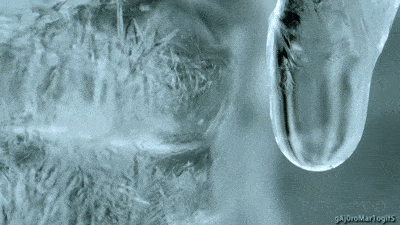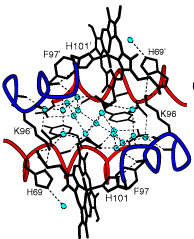The article by Moberg et al. (1) addresses the fundamental question of the number of molecules a water cluster must contain in order to find a significant fraction of the molecules with a hydrogen-bonding arrangement characteristic of ice I, which is a mixture of the structurally similar hexagonal ice Ih and cubic Ic species (2). An early experimental study addressing this question placed the critical cluster size for displaying ice-like behavior between 200 and 1,000 molecules (3). More recent estimates of the smallest water cluster with ice I character range from about 90 to 300 molecules (2, 4⇓⇓–7). The study of Moberg et al. brings to bear experiments and computer simulations to obtain a more precise estimate of the cluster size at which ice I character is manifested and to elucidate the factors responsible for the widespread in earlier estimates of the critical cluster size.

The preparation of isolated water clusters in the gas phase is generally accomplished by using seeded supersonic jet expansion of a mixture of water and a buffer gas. Such expansions start at relatively high temperatures and pressures, with both temperature and pressure decreasing as the expansion proceeds. Depending on the conditions employed in the expansion, the cooling rate can vary appreciably, which can impact the resulting structures. If the cooling rate is too fast, the resulting clusters can be trapped in local energy minima and, thus, not sample thermodynamically more stable structures. In other words, rapid cooling could cause the experiments to sample clusters that are amorphous in nature while, in fact, the crystalline form could be more stable at the final temperature achieved. In the experiments of Moberg et al. (1), the expansion conditions are varied to achieve slow as well as fast cooling (with low stagnation pressure giving slow cooling and high stagnation pressure giving fast cooling). It is estimated that the final cluster temperature is ∼150 K and that, under the slow cooling conditions, the cooling rate is as low as 0.1 K/ns as the final temperature is approached. Achieving a final temperature around 150 K is important, as that is close to the temperature at which simulations predict that water clusters with amorphous and crystalline structures have roughly comparable free energies (2).
One of the most powerful techniques to characterize H-bonding arrangements of water molecules in clusters and the condensed phase is vibrational spectroscopy. However, obtaining vibrational spectra by direct infrared absorption is generally not viable for clusters produced in supersonic jet expansions, due to their low concentrations; as a result, the spectra need to be obtained indirectly through an action spectroscopic technique. In the study of Moberg et al. (1), the vibrational spectra are detected via photoionization of Na atoms that become attached to the clusters when they pass through a pickup cell containing sodium vapor. The photoionization is facilitated by the cluster heating caused by vibrational excitation.
For the clusters produced under slow cooling conditions, there are significant differences in the vibrational spectra in both the H-bonded and the free OH stretch regions in the clusters containing 80 to 99 molecules compared with those containing only 60 to 79 molecules. In particular, in both regions of the spectra, red-shifted shoulders appear for clusters with 80 to 99 molecules but not for the smaller clusters. These spectral features are indicative of the presence of clusters with ice I character, and they are not observed under rapid cooling conditions that lead to fully amorphous clusters. The finding that clusters with detectable ice I cores occur for cluster size near 90 molecules is consistent with an earlier theoretical prediction of Bandow and Hartke (7). The detection of such clusters only when the expansion conditions result in slow cooling suggests that the widespread in previously reported values of the cluster size at which ice I character first appears is a consequence of differences in the expansion conditions.
The study of Moberg et al. (1) also reports results of molecular dynamics simulations of the properties of water clusters in the 70- to the 290-molecule size range. The simulations employed an intermolecular potential model that accurately describes the water−water interactions (8) and was started from both amorphous and crystalline ice I initial structures. The calculated vibrational spectra for clusters containing 90 or 159 molecules show red-shifted shoulders that are not present in the calculated spectrum for the cluster containing 70 molecules. This is consistent with the experimental finding that the smallest cluster displaying ice I character contains around 90 molecules. The simulations also indicate that the clusters that display spectral shifts indicative of ice I have ice-like cores with amorphous outer shells, with the fraction of molecules in the ice-like core growing with increasing cluster size. The ice I core/amorphous outer shell structure of clusters that have some ice I character was predicted by Buch et al. (6). Its origin is easy to understand: Namely, if one extracts a cluster with ∼90 or more water molecules from the crystalline solid and then allows it to relax, the surface layers would reconstruct so as to increase the number of H bonds.

The experimental vibrational spectra for clusters in the ∼90- to 150-molecule range formed under the slow cooling conditions are consistent with their arising from mixtures of clusters that are purely amorphous and those with ice I-like cores and amorphous outer shells. In this context, it is relevant to note that the simulations predict that, in this size range, the ice-like and amorphous forms have similar free energies near T = 150 K. The interpretation that the observed spectra arise from such mixtures is supported by a comparison of the experimental spectra with spectra generated by combining results from the simulations of the 2 types of structures. The presence of a mixture of amorphous and crystalline core clusters could reflect a static situation in which these 2 types of structures do not interconvert on the timescale of the experiment, or it could reflect the more interesting possibility that the clusters oscillate between the 2 types of structures on the timescale of the experiment. Support for the latter interpretation is provided by simulations by Johnston and Molinero (2) using the coarse-grained mW water model (9) that predict that, at T = 150 K, the (H2O)137 cluster oscillates between structures with ice I core with an amorphous shell and purely amorphous structures, with multiple oscillations occurring over hundreds of nanoseconds.
It would be computationally prohibitive to carry out molecular dynamics simulations for hundreds of nanoseconds on a water cluster containing 137 water molecules using the state-of-the-art all-atom water−water model employed in the simulations of the vibrational spectra reported by Moberg et al. (1). This illustrates the importance of coarse-grained models for elucidating the dynamics of melting/freezing and nucleation, where long timescales are at play.
Oscillations between solid-like and liquid-like phases of clusters have been known for over 3 decades, and have been analyzed in detail by Berry and Wales (10, 11). These authors established the connection between the oscillatory phase behavior and the clusters’ having different freezing and melting points, unlike the situation in macroscopic systems for which these 2 quantities are the same. Oscillations between solid-like and liquid-like structures have been observed in simulations of water clusters as small as the octamer (Fig. 1) (12⇓–14). Molecular dynamics simulations of Laria et al. predict the oscillations in (H2O)8 to occur on a picosecond timescale (13), several orders of magnitude faster than the oscillatory behavior characterized in Johnston and Molinero’s (2) simulations of (H2O)137 and presumably occurring in clusters of around this size in the experiments of Moberg et al. (1). For a cluster as small as (H2O)8, there is the question of whether it is more appropriate to view the process as isomerization rather than as a solid/liquid phase change. The nature of the calculated free energy vs. temperature curve provides support for the latter interpretation (14).